MATLAB课程论文要求(含论文模板)
MATLAB结课论文
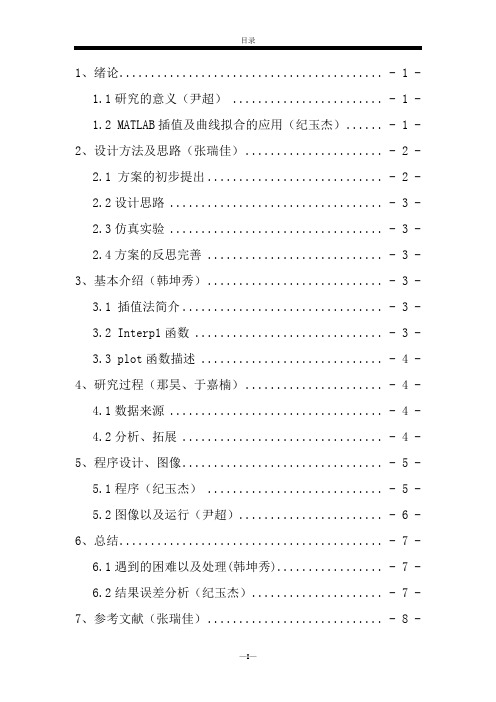
1、绪论.......................................... - 1 -1.1研究的意义(尹超) ........................ - 1 -1.2 MATLAB插值及曲线拟合的应用(纪玉杰)...... - 1 -2、设计方法及思路(张瑞佳)...................... - 2 -2.1 方案的初步提出............................ - 2 -2.2设计思路 .................................. - 3 -2.3仿真实验 .................................. - 3 -2.4方案的反思完善 ............................ - 3 -3、基本介绍(韩坤秀)............................ - 3 -3.1 插值法简介................................ - 3 -3.2 Interp1函数 .............................. - 3 -3.3 plot函数描述 ............................. - 4 -4、研究过程(那昊、于嘉楠)...................... - 4 -4.1数据来源 .................................. - 4 -4.2分析、拓展 ................................ - 4 -5、程序设计、图像................................ - 5 -5.1程序(纪玉杰) ............................ - 5 -5.2图像以及运行(尹超)....................... - 6 -6、总结.......................................... - 7 -6.1遇到的困难以及处理(韩坤秀) ................. - 7 -6.2结果误差分析(纪玉杰)..................... - 7 -7、参考文献(张瑞佳)............................ - 8 -1、绪论1.1研究的意义(尹超)温度是生活及生产中最基本的物理量,它表征的是物体的冷热程度。
matlab运用论文

MATLAB实验报告一、实验目的掌握数值计算方法,包括数组和数组函数,矩阵和矩阵函数的创建与操作,关系与逻辑操作符的运算,多项式计算,数据分析,以及方程与方程组的解法。
掌握 MATLAB 图形和 3D 可视化技术,围绕数据成图机理,绘图要旨和修饰技法熟悉各种绘图指令和交互操作工具。
包括二维,三维和高维图形绘制,图形的色彩,光源和材质等效果处理,以及图形句柄操作和动画制作技术。
二.实验内容1、MA TLAB 数值计算数值计算功能是 MA TLAB 最具代表性的特点,也是最基本、最重要的功能,它是备受欢迎的基石。
MATLAB 能够成为世界上最优秀的数学软件之一和它出色的数值运算能力是分不开的。
MA TLAB 在数值运算中以数组和矩阵为基础。
数组是 MA TLAB 运算中一个重要的数据组织形式。
按其维数可以分为一维、二维数组和多为数组。
矩阵则是 MA TLAB 的基本运算单元。
本次实训重要从以下几个实验来了解 MATLAB 的数值计算方法和功能。
(1)进行数组[1 3 5 7;2 4 6 8]和[3 2 1 1;2 3 2 1]的基本运算。
a=[1 3 5 7;2 4 6 8]; b=[3 2 1 1 2 3 2 1]; c=a+b %a 和 b 的和 d=a.*b %a 和 b 的差 e=b.\a %b 和 a 的商 f=3.^b %以 3 为底,以 b 中各元素为指数求得的幂构成的数组运行结果: c= 4 4 5 7 6 8 8 9 d= 3 4 6 12 5 12 7 8 e= 0.3333 1.0000 1.5000 1.3333 5.0000 3.0000 7.000 0 8.0000 f= 27 9 3 3 9 27 9 3(2) 求解方程 x^3+5x^2-8x+6=0 的根。
p=[1 5 -8 6]; roots(p) 运行结果: ans = -6.3972 0.6986 + 0.6707i 0.6986 - 0.6707i(3)求解下列方程组的根 2x(1)+x(2)-5x(3)+x(4)=8 ; x(1)-3x(2)-6x(4)=9; 2x(2)-x(3)+2x(4)=-5 ; x (1)+4x(2)-7x(3)+6x(4)=0在 MA TLAB 中的求解过程如下: A=[2 1 -5 1; 1 -3 0 -6; 0 2 -1 2; 1 4 -7 6]; B=[8 9 -5 0]’; x=A/B 运行结果: x= 3.0000 -4.0000 -1.0000 1.0000 2.MATLAB 图形和 3D 可视化技术科学计算常常把计算结果以图形的形式表现出来,MATLAB 不仅在数值上独占鳌头,而且在数据可视化方面功能也非常强大,足以胜任大多数场合的需求。
Matlab论文模板

Paper Title (use style: paper title) Subtitle as neededAuthors Name/s per 1st Affiliation(Author)line 1 (of Affiliation): dept. nameof organizationline 2: name of organization,acronyms acceptableline 3: City, Countryline 4: e-mail: name@Authors Name/s per 2ndAffiliation (Author)line 1 (of Affiliation): dept. nameof organizationline 2: name of organization, acronyms acceptableline 3: City, Countryline 4: e-mail: name@Abstract—This electronic document is a “live” template. T he various components of your paper [title, text, heads, etc.] are already defined on the style sheet, as illustrated by the portions given in this document. DO NOT USE SPECIAL CHARACTERS, SYMBOLS, OR MATH IN YOUR TITLE OR ABSTRACT. (Abstract) Keywords-component; formatting; style; styling; insert (key words)I.I NTRODUCTION (H EADING 1) All manuscripts must be in English. These guidelines include complete descriptions of the fonts, spacing, and related information for producing your proceedings manuscripts. Please follow them and if you have any questions, direct them to the production editor in charge of your proceedings at Conference Publishing Services (CPS): Phone +1 (714) 821-8380 or Fax +1 (714) 761-1784.This template provides authors with most of the formatting specifications needed for preparing electronic versions of their papers. All standard paper components have been specified for three reasons: (1) ease of use when formatting individual papers, (2) automatic compliance to electronic requirements that facilitate the concurrent or later production of electronic products, and (3) conformity of style throughout a conference proceedings. Margins, column widths, line spacing, and type styles are built-in; examples of the type styles are provided throughoutthis document and are identified in italic type, within parentheses, following the example. PLEASE DO NOT RE-ADJUST THESE MARGINS. Some components, such as multi-leveled equations, graphics, and tables are not prescribed, although the various table text styles are provided. The formatter will need to create these components, incorporating the applicable criteria that follow.II.T YPE S TYLE AND F ONTS Wherever Times is specified, Times Roman or Times New Roman may be used. If neither is available on your word processor, please use the font closest in appearance to Times. Avoid using bit-mapped fonts if possible. True-Type 1 or Open Type fonts are preferred. Please embed symbol fonts, as well, for math, etc.III.E ASE OF U SEA.Selecting a Template (Heading 2) First, confirm that you have the correct template for your paper size. This template has been tailored for output on the US-letter paper size. If you are using A4-sized paper, please close this template and download the file for A4 paper format called ―CPS_A4_format‖.B.Maintaining the Integrity of the SpecificationsThe template is used to format your paper and style the text. All margins, column widths, line spaces, and text fonts are prescribed; please do not alter them. You may note peculiarities. For example, the head margin in this template measures proportionately more than is customary. This measurement and others are deliberate, using specifications that anticipate your paper as one part of the entire proceedings, and not as an independent document. Please do not revise any of the current designations. IV.P REPARE Y OUR P APER B EFORES TYLINGBefore you begin to format your paper, first write and save the content as a separate text file. Keep your text and graphic files separate until after the text has been formatted and styled. Do not use hard tabs, and limit use of hard returns to only one return at the end of a paragraph. Do not add any kind of pagination anywhere in the paper. Do not number text heads-the template will do that for you. Finally, complete content and organizational editing before formatting. Please take note of the following items when proofreading spelling and grammar:A.Abbreviations and Acronyms Define abbreviations and acronyms the first time they are used in the text, even after they have been defined in the abstract. Abbreviations such as IEEE, SI, MKS, CGS, sc, dc, and rms do not have to be defined. Do not use abbreviations in the title or heads unless they are unavoidable.B.Units∙Use either SI (MKS) or CGS as primary units. (SI units areencouraged.) English units maybe used as secondary units (inparentheses). An exceptionwould be the use of Englishunits as identifiers in trade, suchas ―3.5-inch disk drive‖.∙Avoid combining SI and CGS units, such as current in amperesand magnetic field in oersteds.This often leads to confusionbecause equations do notbalance dimensionally. If youmust use mixed units, clearlystate the units for each quantitythat you use in an equation.∙Do not mix complete spellings and abbreviations of units:―Wb/m2‖ or ―webers per squaremeter‖, not ―webers/m2‖. Spellout units when they appear intext: ―. . . a few henries‖, not ―. . .a few H‖.∙Use a zero before decimal points: ―0.25‖, not ―.25‖.C.EquationsThe equations are an exception to the prescribed specifications of this template. You will need to determine whether or not your equation should be typed using either the Times New Roman or the Symbol font (please no other font). To create multileveled equations, it may be necessary to treat the equation as a graphic and insert it into the text after your paper is styled. Number equations consecutively. Equation numbers, within parentheses, are to position flush right, as in (1), using a right tab stop. To make your equations more compact, you may use the solidus ( / ), the exp function, or appropriate exponents. Italicize Roman symbols for quantities and variables, but not Greek symbols. Use a long dash rather than a hyphen for a minus sign. Punctuate equations with commas or periods when they are part of a sentence, as inα + β = χ. (1) Note that the equation is centered using a center tab stop. Be sure that the symbols in your equation have been defined before or immediately following the equation. Use ―(1)‖, not ―Eq. (1)‖ or ―equation (1)‖, except at the beginning of a sentence: ―Equation (1) is . . .‖D.Some Common Mistakes∙The word ―data‖ is plural, not singular.∙The subscript for the permeability of vacuum μ0, andother common scientificconstants, is zero with subscriptformatting, not a lowercase letter―o‖.∙In American English, commas, semi-/colons, periods, questionand exclamation marks arelocated within quotation marksonly when a complete thought orname is cited, such as a title orfull quotation. When quotationmarks are used, instead of a boldor italic typeface, to highlight aword or phrase, punctuationshould appear outside of thequotation marks. A parentheticalphrase or statement at the end ofa sentence is punctuated outsideof the closing parenthesis (likethis). (A parenthetical sentenceis punctuated within theparentheses.)∙ A graph within a graph is an ―inset‖, not an ―insert‖. Theword alternatively is preferred tothe word ―alternately‖ (unlessyou really mean something thatalternates).∙Do not use the word ―essentially‖ to mean―approximately‖ or ―effectively‖.∙In your paper title, if the words ―that uses‖ can accuratelyreplace the word ―using‖,capitalize the ―u‖; if not, keepusing lower-cased.∙Be aware of the different meanings of the homophones―affect‖ and ―effect‖,―complement‖ and―compliment‖, ―discreet‖ and―discrete‖, ―principal‖ and―principle‖.∙Do not confuse ―imply‖ and ―infer‖.∙The prefix ―non‖ is not a word;it should be joined to the word itmodifies, usually without ahyphen.∙There is no period after the ―et‖ in the Latin abbreviati on ―et al.‖.∙The abbreviation ―i.e.‖ means ―that is‖, and the abbreviation―e.g.‖ means ―for example‖.An excellent style manual for science writers is [7].V.U SING THE T EMPLATE After the text edit has been completed, the paper is ready for the template. Duplicate the template file by using the Save As command, and use the naming convention prescribed by your conference for the name of your paper. In this newly created file, highlight all of the contents andimport your prepared text file. You are now ready to style your paper. A.Authors and AffiliationsThe template is designed so that author affiliations are not repeated each time for multiple authors of the same affiliation. Please keep your affiliations as succinct as possible (for example, do not differentiate among departments of the same organization). This template was designed for two affiliations.1)For author/s of only one affiliation (Heading 3): To change the default, adjust the template as follows.a)Selection (Heading 4): Highlight all author and affiliation lines.b)Change number of columns: Select Format > Columns >Presets > One Column.c)Deletion: Delete the author and affiliation lines for the second affiliation.d)For author/s of more than two affiliations: To change the default, adjust the template as follows.e)Selection: Highlight all author and affiliation lines.f)Change number of columns: Select Format > Columns > Presets > One Column.g)Highlight author and affiliation lines of affiliation 1 and copy this selection.h)Formatting: Insert one hard return immediately after the last character of the last affiliation line. Then paste the copy of affiliation 1. Repeat as necessary for each additional affiliation.i)Reassign number of columns: Place your cursor to the right of the last character of the last affiliation line of an even numbered affiliation (e.g., if there are five affiliations, place your cursor at end of fourth affiliation). Drag the cursor up to highlight all of the above author and affiliation lines. Go to Format > Columns and select ―2 Columns‖. If you have an odd number of affiliations, the final affiliation will be centered on the page; all previous will be in two columns.B.Identify the Headings Headings, or heads, are organizational devices that guide the reader through your paper. There are two types: component heads and text heads.Component heads identify the different components of your paper and are not topically subordinate to each other. Examples include Acknowledgments and References and, for these, the correct style to use is ―Heading5‖. Use ―figure caption‖ for your Figure captions, and ―table head‖ for your table title. Run-inheads, such as ―Abstract‖, will require you to apply a style (in this case, italic) in addition to the style provided by the drop down menu to differentiate the head from the text. Text heads organize the topics on a relational, hierarchical basis. For example, the paper title is the primary text head because all subsequent material relates and elaborates on this one topic. If there are two or more sub-topics, the next level head (uppercase Roman numerals) should be used and, conversely, if there are not at least two sub-topics, then no subheads should be introduced. Styles named ―Heading 1‖, ―Heading 2‖, ―Heading 3‖, and ―Heading 4‖ are prescribed.C.Figures and Tables1) Positioning Figures and Tables: Place figures and tables at the top and bottom of columns. Avoid placing them in the middle of columns. Large figures and tables may span across both columns. Figure captions should be below the figures; table heads should appear above the tables. Insert figures and tables after they are cited in the text. Use the abbreviation ―Fig. 1‖, even at the beginning of a sentence.TABLE I.T ABLE T YPE S TYLESa. Sample of a Table footnote. (Tablefootnote)Figure 1.Example of a ONE-COLUMNfigure caption.Please see last page of this document for AN EXAMPLE of a 2-COLUMN Figure.Figure Labels: Use 8 point Times New Roman for Figure labels. Use words rather than symbols or abbreviations when writing Figure axis labels to avoid confusing the reader. As an example, write the quantity ―Magnetization‖, or ―Magnetization, M‖, not just ―M‖. If including units in the label, present them within parentheses. Do not label axes only with units. In the example, write ―Magnetization (A/m)‖ or ―Magnetization {A[m(1)]}‖, not just ―A/m‖. Do not label axes with a ratio of quantities and units. For example,write ―Temperature (K)‖, not ―Temperature/K‖.D.FootnotesUse footnotes sparingly (or not at all) and place them at the bottom of the column on the page on which they are referenced. Use Times 8-point type, single-spaced. To help your readers, avoid using footnotes altogether and include necessary peripheral observations in the text (within parentheses, if you prefer, as in this sentence).VI.C OPYRIGHT F ORMS ANDR EPRINT O RDERSYou must submit the IEEE Electronic Copyright Form (ECF) per Step 7 of the CPS author kit’s web page. THIS FORM MUST BE SUBMITTED IN ORDER TO PUBLISH YOUR PAPER.Please see Step 9 for ordering reprints of your paper. Reprints may be ordered using the form provided as <reprint.doc> or <reprint.pdf>.A CKNOWLEDGMENTThe preferred spelling of the word ―acknowledgment‖ in America is without an ―e‖ after the ―g‖. Avoid the stilted expression, ―One of us (R.B.G.) thanks . . .‖ Instead, try ―R.B.G. thanks‖. Put applicable sponsor acknowledgments here; DO NOT place them on the first page of your paper or as a footnote.R EFERENCESList and number all bibliographical references in 9-point Times, single-spaced, at the end of your paper. When referenced in the text, enclose the citation number in square brackets, for example [1]. Where appropriate, include the name(s) of editors of referenced books. The template will number citations consecutively within brackets [1]. The sentence punctuation follows the bracket [2]. Refer simply to the reference number, as in [3]—do not use ―Ref. [3]‖ or ―reference [3]‖ except at the beginning of a sentence: ―Reference [3] was the first . . .‖Number footnotes separately in superscripts. Place the actual footnote at the bottom of the column in which it was cited. Do not put footnotes in the reference list. Use letters for table footnotes.Unless there are six authors or more give all aut hors’ names; do not use ―et al.‖. Papers that have not been published, even if they have been submitted for publication, should be cited as ―unpublished‖ [4]. Papers that have been accepted for publication should be cited as ―in press‖ [5]. Capitalize only the firstword in a paper title, except for proper nouns and element symbols. For papers published in translation journals, please give the English citation first, followed by the original foreign-language citation [6].[1]G. Eason, B. Noble, and I. N.Sned don, ―On certain integrals of Lipschitz-Hankel type involving products of Bessel functions,‖ Phil.Trans. Roy. Soc. London, vol.A247, pp. 529–551, April 1955.(references)[2]J. Clerk Maxwell, A Treatise onElectricity and Magnetism, 3rd ed., vol. 2. Oxford: Clarendon, 1892, pp.68–73.[3]I. S. Jacobs and C. P. Bean, ―Fineparticles, thin films and exchange anisotropy,‖ in Magnetism, vol. III,G. T. Rado and H. Suhl, Eds. NewYork: Academic, 1963, pp. 271–350.[4]K. Elissa, ―Title of paper ifknown,‖ unpublished.[5]R. Nicole, ―Title of paper withonly first word capitalized,‖ J.Name Stand. Abbrev., in press. [6]Y. Yorozu, M. Hirano, K. Oka,and Y. Tagawa, ―Electron spectroscopy studies on magneto-optical media and plastic substrate interface,‖ IEEE Transl. J. Magn.Japan, vol. 2, pp. 740–741, August 1987 [Digests 9th Annual Conf.Magnetics Japan, p. 301, 1982]. [7]M. Young, The Technical Writer’sHandbook. Mill Valley, CA: University Science, 1989.[8]Electronic Publication: DigitalObject Identifiers (DOIs):Article in a journal:[9] D. Kornack and P. Rakic, ―CellProliferation without Neurogenesis in Adult Primate Neocortex,‖ Science, vol. 294, Dec. 2001, pp.2127-2130,doi:10.1126/science.1065467. Article in a conference proceedings: [10]H. Goto, Y. Hasegawa, and M.Tanaka, ―Efficien t Scheduling Focusing on the Duality of MPL Representatives,‖ Proc. IEEE Symp. Computational Intelligence in Scheduling (SCIS 07), IEEE Press, Dec. 2007, pp. 57-64, doi:10.1109/SCIS.2007.357670.Figure 2. Example of a TWO-COLUMN figure caption: (a) this is the format forreferencing parts of a figure.。
matlab课程论文要求

matlab课程论文要求一、时间安排(一)2016年X月X日之前必须提交纸质版(时间待定,另行通知,尽早完成,以免影响其他科目的复习考试)。
(二)电子版统一写清楚学号(学号在前)+姓名+专业发送给学委。
打包文件夹发送给我,不接受单独发给我的。
二、选题(一)选题要紧密结合本学科专业的教学科研和MATLAB,符合专业培养目标的要求。
(二)论文一般为一人一题,严格控制与往年的重复率。
三、成绩评定平时成绩(0.3)+课程论文(0.7)=最终成绩。
四、论文写作规范要求(一)封面:封面要使用统一格式。
(二)目录:“目录”两字黑体小二号、居中,“目录”两字间空四格、与正文空一行。
各部分名为宋体小四号字,各小部分名间有缩进。
(三)题目:题目要对论文的内容有高度的概括性,简明、易读,字数应在20个字以内,论文题目用黑体三号字。
(四)署名:论文署名的顺序为:专业学号学生姓名指导老师姓名,用宋体小四号字。
可用以下表示:专业:XXXXX 学号:XXXXX 学生姓名:XXXXX 指导老师姓名:XXXX (五)内容摘要:中文内容摘应简要说明所研究的内容、目的、实验方法、主要成果和特色,一般为200-300字,用宋体小四号字,其中“内容摘要”四个字加粗。
(六)关键词:一般为3-6个,用分号隔开,用宋体小四号字,其中“关键词”三个字加粗。
(七)正文:正文要符合一般学术论文的写作规范,统一用宋体小四号字,行距为1.5倍。
字数一般要求为不得少于5000字。
内容要理论联系实际,涉及到他人的观点、统计数据或计算公式的要注明出处(引注),涉及计算内容的数据要求准确。
标题序号从大到小的顺序为:“1”“1.1”“1.1.1”……。
(八)注释:论文中所引用文献按学术论文规范注明出处,注序要与文中提及的序号一致。
注释方法参见参考文献顺序。
(九)参考文献:论文后要标注参考文献和附录,参考文献按照以下格式排列:1.专著、论文集、学位论文、报告[序号]主要责任者.文献题名[文献类型标识].出版地:出版者,出版年.起止页码。
Matlab课程论文(实验报告)
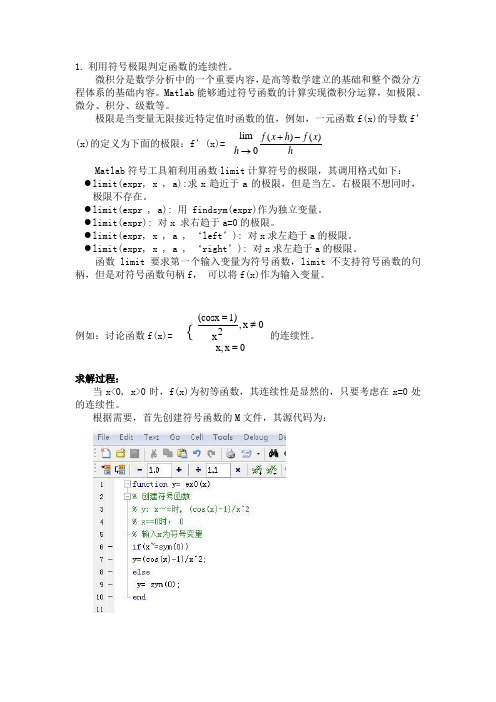
1. 利用符号极限判定函数的连续性。
微积分是数学分析中的一个重要内容,是高等数学建立的基础和整个微分方程体系的基础内容。
Matlab 能够通过符号函数的计算实现微积分运算,如极限、微分、积分、级数等。
极限是当变量无限接近特定值时函数的值,例如,一元函数f(x)的导数f ’(x)的定义为下面的极限:f ’(x)=hx f h x f h )()(0lim -+→ Matlab 符号工具箱利用函数limit 计算符号的极限,其调用格式如下: ● l imit(expr, x , a):求x 趋近于a 的极限,但是当左、右极限不想同时,极限不存在。
● l imit(expr , a): 用 findsym(expr)作为独立变量。
● l imit(expr): 对x 求右趋于a=0的极限。
● l imit(expr, x , a , ‘left ’): 对x 求左趋于a 的极限。
● l imit(expr, x , a , ‘right ’): 对x 求左趋于a 的极限。
函数limit 要求第一个输入变量为符号函数,limit 不支持符号函数的句柄,但是对符号函数句柄f , 可以将f(x)作为输入变量。
例如:讨论函数f(x)= {0x x,0x ,2x 1)(cosx =≠= 的连续性。
求解过程:当x<0, x>0时,f(x)为初等函数,其连续性是显然的,只要考虑在x=0处的连续性。
根据需要,首先创建符号函数的M 文件,其源代码为:保存M 文件,名为ex0.m 。
调用limit 函数判定函数的连续性,代码为由结果可以看出,0lim →x f(x)=+→0lim x f(x)=-→0lim x f(x)=- 1/2 =0=f(0), 所以,在x=0时函数是不连续的。
2.在实际应用中,常常提出这样一种需求:把同一自变量的两个不用量纲、不同数量级的函数量的变化绘制在同一张图上。
例如希望在同一张图上表现出温度、湿度随时间的变化;人口数量、GDP 的变化曲线等。
基于matlab的优秀毕业设计论文很详细(有源程序)很严
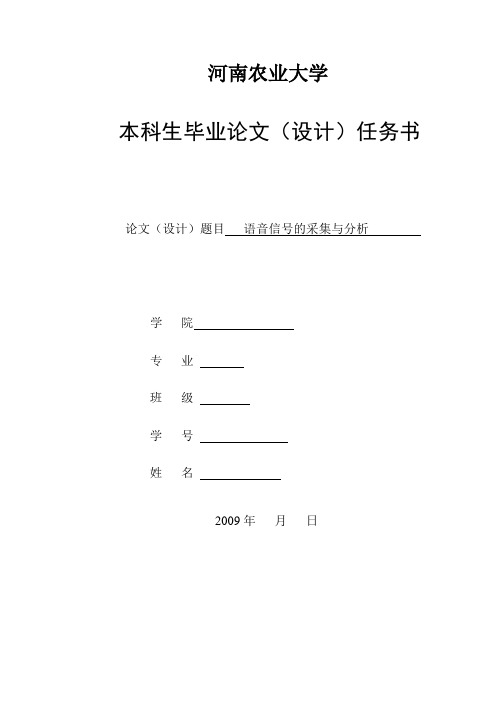
河南农业大学本科生毕业论文(设计)任务书论文(设计)题目语音信号的采集与分析学院专业班级学号姓名2009年月日语音信号的采集与分析作者:123 指导老师:456摘要语音信号的采集与分析技术是一门涉及面很广的交叉科学,它的应用和发展与语音学、声音测量学、电子测量技术以及数字信号处理等学科紧密联系。
其中语音采集和分析仪器的小型化、智能化、数字化以及多功能化的发展越来越快,分析速度较以往也有了大幅度的高。
本文简要介绍了语音信号采集与分析的发展史以及语音信号的特征、采集与分析方法,并通过PC机录制自己的一段声音,运用Matlab进行仿真分析,最后加入噪声进行滤波处理,比较滤波前后的变化。
关键词:语音信号,采集与分析,MatlabAudio signal acquisition and analysisAuthor:zhuyousong Teacher guidance:lifuqiangAbstractSpeech signal acquisition and analysis techniques are a wide range of cross-scientific,Its application and development of voice study, sound measurement study, electronic measuring technology, and digital signal processing disciplines, such as close contact。
Collection and analysis of voice one of the small-scale equipment, intelligence, digital and multi-functional development of more and more quickly, faster than the previous analysis has been substantially high。
matble课程论文(MATLAB在三维作图中的应用)

《MATLAB》课程论文MATLAB在三维作图中的应用姓名:学号:专业:班级:指导老师:学院:完成日期:MATLAB在三维作图中的应用[摘要]MATLAB提供了一系列的绘图函数,用户不仅不许考虑绘图细节,只需给出一些基本的参数就能得到所需要的图形,这一类函数称为高层绘图函数。
除此之外,MATLAB还提供了直接对句柄进行操作的一系列的低层的绘图操作。
这类操作将图形的每个元素看做是一个独立的对象,系统给每个对象独立的分配一个句柄,以后可以通过该句柄对改图元素进行操作,而不影响图形的其他部分。
高层绘图操作简单明了,方便高效,使用户最常使用的绘图方法,而低层绘图操作控制和表现图形的能力更强,为用户自主绘图创造了条件。
其实MATLAB的高层绘图函数都是利用低层绘图函数建立起来的。
所以MATLAB的计算准确、效率高、使用快捷等优点常被广泛应用于科学和工程领域.[关键字]MATLAB语言三维图形图像处理绘制一,问题的提出MATLAB语言是当前国际学科界应用很广泛的一种软件,强大的绘图功能是MATLAB的特点之一。
MATLAB提供了一系列的绘图函数,利用它强大的图像处理来绘制三维图形既简单而且也很方便。
在绘制三维图形的过程中也用到了MATLAB语言的其他功能,绘制三维图形时用到了它提供的一些函数,利用这些函数可以方便的生成一些特殊矩阵,因此可生成一个坐标平面。
MATLAB语言强大的功能也在二维三维绘图中的得到了很广泛的应用,利用它所提供的精细的图像处理功能,如MATLAB还提供了直接对句柄进行操作的一系列的低层的绘图操作。
这类操作将图形的每个元素看做是一个独立的对象,系统给每个对象独立的分配一个句柄,以后可以通过该句柄对改图元素进行操作,而不影响图形的其他部分。
高层绘图操作简单明了,使用户最常使用的绘图方法,而低层绘图操作控制和表现图形的能力更强,为用户自主绘图创造了条件,还可以对所绘制的三维图形作一个修饰的处理。
MATLAB论文【范本模板】

本科课程设计题目:连续时间信号傅里叶级数分析及MATLAB实现院系:信息工程学院姓名:周莎莎学号:1434140161专业:通信工程年级:2014 级指导教师:温金芳职称:讲师完成日期:2016年6月目录摘要 (I)A BSTRACT (II)绪论 01MATLAB简介 (1)1.1MATLAB语言功能 (1)1。
2MATLAB语言特点 (1)2 连续时间周期信号的傅里叶级数 (2)2。
1连续时间周期信号的分解 (2)2.1.1三角形式的傅里叶级数 (2)2。
1。
2指数形式的傅里叶级数 (3)2.2连续时间周期信号的傅里叶综合 (3)2.3吉布斯现象 (4)3连续时间周期信号的频谱分析 (6)3.1单边与双边频谱关系 (6)3。
2以单边幅度频谱为例,研究脉冲宽度与频谱的关系 (7)3.3以单边幅度频谱为例,研究脉冲周期与频谱的关系 (8)4 典型周期脉冲的频谱 (10)4.1周期方波脉冲频谱的MATLAB实现 (10)4。
1。
1周期方波脉冲双边频谱的MATLAB实现 (10)4.1.2 周期方波脉冲单边频谱的MATLAB实现 (12)4.2周期三角波脉冲频谱的MATLAB实现 (14)4。
2。
1 周期三角波双边频谱的MATLAB实现 (15)4。
2。
2 周期三角波单边频谱的MATLAB实现 (16)5小结 (18)致谢 (19)参考文献 (20)附录 (21)摘要MATLAB目前已发展成为由MATLAB 语言、MATLAB 工作环境、MATLAB 图形处理系统、MATLAB 数学函数库和MATLAB 应用程序接口五大部分组成的集数值计算、图形处理、程序开发为一体的功能强大的系统。
本次课程设计则在深入研究连续时间信号傅里叶级数分析理论知识的基础上,利用MATLAB强大的图形处理功能、符号运算功能以及数值计算功能,通过MATLAB编程进行图形功能仿真,从而实现连续时间周期信号频域分析的仿真波形,包括以下内容:用MATLAB实现周期信号的傅里叶级数分解与综合的波形;用MATLAB 实现周期信号的单边频谱及双边频谱的波形与分析;用MATLAB实现典型周期信号的频谱的波形。
(完整版)matlab毕业设计论文
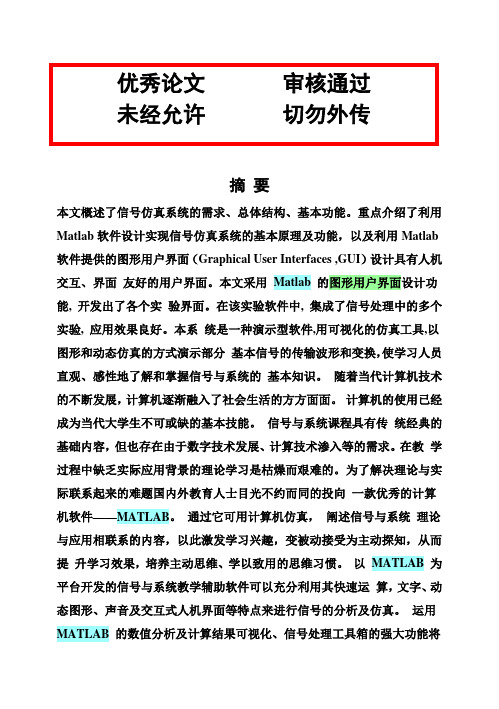
摘要本文概述了信号仿真系统的需求、总体结构、基本功能。
重点介绍了利用Matlab软件设计实现信号仿真系统的基本原理及功能,以及利用Matlab 软件提供的图形用户界面(Graphical User Interfaces ,GUI)设计具有人机交互、界面友好的用户界面。
本文采用Matlab 的图形用户界面设计功能, 开发出了各个实验界面。
在该实验软件中, 集成了信号处理中的多个实验, 应用效果良好。
本系统是一种演示型软件,用可视化的仿真工具,以图形和动态仿真的方式演示部分基本信号的传输波形和变换,使学习人员直观、感性地了解和掌握信号与系统的基本知识。
随着当代计算机技术的不断发展,计算机逐渐融入了社会生活的方方面面。
计算机的使用已经成为当代大学生不可或缺的基本技能。
信号与系统课程具有传统经典的基础内容,但也存在由于数字技术发展、计算技术渗入等的需求。
在教学过程中缺乏实际应用背景的理论学习是枯燥而艰难的。
为了解决理论与实际联系起来的难题国内外教育人士目光不约而同的投向一款优秀的计算机软件——MATLAB。
通过它可用计算机仿真,阐述信号与系统理论与应用相联系的内容,以此激发学习兴趣,变被动接受为主动探知,从而提升学习效果,培养主动思维、学以致用的思维习惯。
以MATLAB 为平台开发的信号与系统教学辅助软件可以充分利用其快速运算,文字、动态图形、声音及交互式人机界面等特点来进行信号的分析及仿真。
运用MATLAB 的数值分析及计算结果可视化、信号处理工具箱的强大功能将信号与系统课程中较难掌握和理解的重点理论和方法通过概念浏览动态演示及典型例题分析等方式,形象生动的展现出来,从而使学生对所学知识理解更加透彻。
同时运用教学软件中的数值计算工具箱,将学生从大量繁琐的手工数学运算中解放出来,将更多时间留给对基本概念和基本方法的思考。
关键词:关键词:信号与系统,matlab,应用分析ABSTRACTAs the modern computer technology development, computer gradually merged with the various aspects of social life. the use of the computer essential part of the basic skills of students. the signal and systems of traditional classic of course, but there is also due to a digital technology development, the technology in the demand. in the teaching process of the practical application of theoretical study is boring and difficult. Theory with practice in order to solve the problem of educational circles and looked into a simultaneous of computer software —— matlab. it can be used by computer simulations, signals with the system theory and application related to the content, it aroused interest in learning and became passive acceptance of the initiative and thereby elevate learning, training of active in the make full use of its rapid operation of graphic, text, dynamic and interactive voice man-machine interface to the characteristics of the analysis and emulation. To the platform of the development of matlab signal system of teaching and assistive software can make full use of its rapid operation of graphic, text, dynamic and interactive voice man-machine interface to the characteristics of theanalysis and emulation. KEY WORDS:signal and system,matlab,An analysis目录前言 (1)第 1 章绪论 (2)1.1论文写作背景 (2)1.2研究问题的提出 (3)1.3研究问题的解决方案 (4)第 2 章MATLAB 软件简介 (6)2.1MAILAB 简介及发展过程 (6)2.2MATLAB 入门 (7)2.3MATLAB 语言平台简单介绍 (9)第 3 章信号与系统简介 (11)3.1信号与系统发展过程 (11)3.2信号与系统课程特点及重点内容 (12)3.3信号与系统涉及内容 (13)第 4 章MATLAB 在信号与系统中的应用 (15)4.1MATLAB 中信号表示及可视化 (15)4.2MATLAB 在信号与系统分析中的应用 (17)4.2.1 MATLAB 在时域、频域、S 域、Z 域里的应用举例 (17)4.2.2MATLAB 在信号调制、滤波及求解中的应用 (24)第 5 章GUI 界面的创建与应用 (31)5.1结GUI 界面创建的基本知识 (31)5.2 GUI 界面在信号与系统中的应用 (33)5.3信号与系统实验平台设计 (36)结论 (47)参考文献 (48)致谢 (49)前言随着我国高等教育逐步的实现了大众化以及产业结构进一步调整,社会对人才的需要出现了层次化和多样化的变化,这反映到高等学校的定位与教学要求中,必然会带来教学内容上的差异化和教学方式上的多样化。
matlab 论文
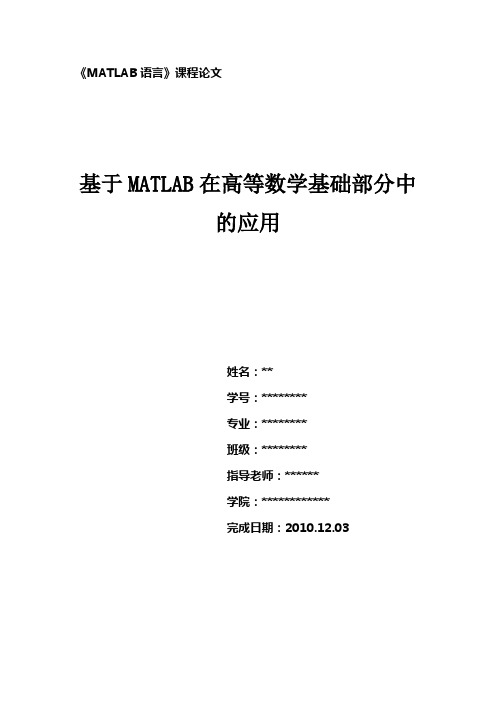
《MATLAB语言》课程论文基于MATLAB在高等数学基础部分中的应用姓名:**学号:********专业:********班级:********指导老师:******学院:************完成日期:2010.12.03MATLAB在高等数学基础部分中的应用(姓名 12010245280 2010级自动化1班)[摘要]计算机的发明是二十世纪四十年代的事情,经过几十年的发展,它已经成为一门复杂的工程技术学科,它的应用从国防、科学计算,到家庭办公、教育娱乐,无所不在。
它的分类从巨型机、大型机、小型机,到工作站、个人电脑,五花八门。
但是,无论怎样尖端,怎样高科技,从它诞生之日起,在许多人心目中它就是一部机器,一部冰冷的高速运算的机器。
从ENIAC揭开计算机时代的序幕,到UNIVAC成为迎来计算机时代的宠儿,不难看出这里发生了两个根本性的变化:一是计算机已从实验室大步走向社会,正式成为商品交付客户使用;二是计算机已从单纯的军事用途进入公众的数据处理领域,真正引起了社会的强烈反响。
随着计算机的日趋普及和计算机技术的发展.汁算机辅助教学逐渐称为一种重要的教学方式,Matlab是MathWorks公司出品的一款著名数学软件.是当今国际上科学界(尤其是自动控制领域)最具影响力、也是最有活力的软件。
它起源丁-矩阵运算,并已经发展成一种高度集成的计算机语言。
它提供r强大的科学运算、灵活的程序没计流程、高质肇的图形可视化与界面设计、便捷的与其他程序和语言接f1的功能:Matlab语言在各国高校与研究单位起着重大的作用。
应用Matlab进行高等数学的计算机辅助教学。
能够加深我们对所学高等数学知识的理解。
并应用数学软件进行计算,把我们从繁琐的计算中解脱出来。
MATLAB 和Mathematica、Maple并称为三大数学软件。
它在数学类科技应用软件中在数值计算方面首屈一指。
MATLAB可以进行矩阵运算、绘制函数和数据、实现算法、创建用户界面、连接其他编程语言的程序等,主要应用于工程计算、控制设计、信号处理与通讯、图像处理、信号检测、金融建模设计与分析等领域。
MATLAB课设论文
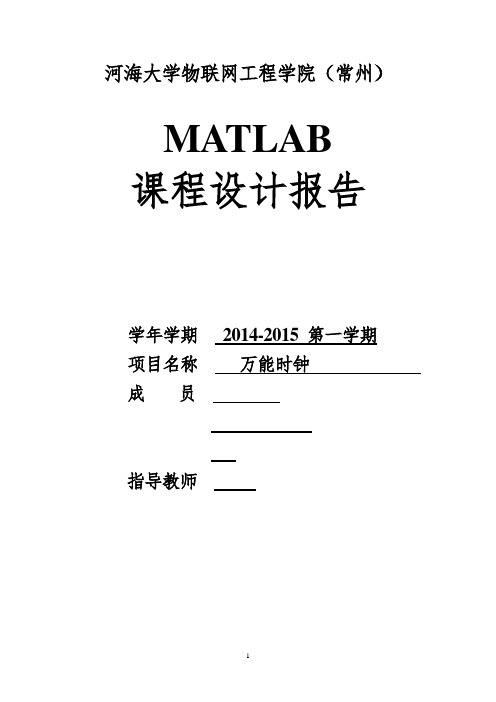
河海大学物联网工程学院(常州)MATLAB课程设计报告学年学期2014-2015 第一学期项目名称万能时钟成员指导教师目录一.分组分工 (3)二.设计理念 (3)三.模块设计 (4)四.缺憾补充 (11)五.实践心得 (11)一.分组分工二.设计理念时钟与我们的生活息息相关。
远渡他国,我们需要调节时差,以确认正确的当地时间;睡梦中,我们需要闹钟将我们唤醒;800米起跑线上,我们需要计时器记录我们的用时成绩······一个集多种功能的时钟可以大大方便我们的生活。
经过商议,我们确定MATLAB设计的课题为设计一个多功能时钟。
它包含时钟功能、计时功能、闹钟功能。
其中时钟功能默认显示北京时间,也可以随时随意更换其他时区的时刻;闹钟功能支持音频以及视频的播放,除了系统自带的音乐,我们也可以根据自身爱好,选择其他音乐。
三.模块设计(1)模块名称:时钟模块模块功能:界面出现实时时钟和可转换时区模块背景描述:白色背景有一个时钟设计思路及技术要点:将系统实时时间转换成时钟的秒针分针时针的位置,时区时间变成一个可选择的关键代码及描述:计算时针.分针.秒针的位置function TimeUpdate(obj,eventdata,handles) %定时器回调函数global VarTime;global Title;%VarTimeNowTime=fix(clock);if NowTime(4)+VarTime<0NowTime(3)=NowTime(3)-1;NowTime(4)=NowTime(4)+VarTime+24;elseif NowTime(4)+VarTime>=24NowTime(3)=NowTime(3)+1;NowTime(4)=NowTime(4)+VarTime-24;elseNowTime(4)=NowTime(4)+VarTime;endStrTime= sprintf('%d年%d月%d日%d时%d分%d秒',NowTime);set(handles.date,'String',StrTime);%global hh;global hm;global hs;axes(handles.axes1);ti=NowTime;%ti=clock;% 计算时针位置th=-(ti(4)+ti(5)/60+ti(6)/3600)/12*2*pi+pi/2;xh3=4.0*cos(th);yh3=4.0*sin(th);xh2=xh3/2+0.5*cos(th-pi/2);yh2=yh3/2+0.5*sin(th-pi/2);xh4=xh3/2-0.5*cos(th-pi/2);yh4=yh3/2-0.5*sin(th-pi/2);set(hh,'XData',[0 xh2 xh3 xh4 0],'YData',[0 yh2 yh3 yh4 0])% 计算分针位置tm=-(ti(5)+ti(6)/60)/60*2*pi+pi/2;xm3=6.0*cos(tm);ym3=6.0*sin(tm);xm2=xm3/2+0.5*cos(tm-pi/2);ym2=ym3/2+0.5*sin(tm-pi/2);xm4=xm3/2-0.5*cos(tm-pi/2);ym4=ym3/2-0.5*sin(tm-pi/2);set(hm,'XData',[0 xm2 xm3 xm4 0],'YData',[0 ym2 ym3 ym4 0])% 计算秒针位置ts=-(ti(6))/60*2*pi+pi/2;set(hs,'XData',[0 7*cos(ts)],'YData',[0 7*sin(ts)])drawnow;分区选择switch TimeZoneString{SelZone} %以北京时间为例,VarTime=0; 以后要加其它的时区,只要按如下格式输入case分支,并且在popupmenu 为TimeZone中输入相应的字符串,例如北京时间为(GMT+08:00)北京时间case '(GMT-12:00)日界线西'Title='日界线西时间';set(handles.TimeZoneStr,'string',Title);VarTime=-20;case '(GMT-10:00)夏威夷时间'Title='夏威夷时间';set(handles.TimeZoneStr,'string',Title);VarTime=-18;case '(GMT-06:00)中部时间(美国)'Title='中部时间(美国)';set(handles.TimeZoneStr,'string',Title);VarTime=-14;case '(GMT-04:00)加拿大时间'Title='加拿大时间';set(handles.TimeZoneStr,'string',Title);VarTime=-12;case '(GMT)格林威治标准时间'Title='格林威治标准时间'set(handles.TimeZoneStr,'string',Title);VarTime=-8;case '(GMT+02:00)雅典时间'Title='雅典时间';set(handles.TimeZoneStr,'string',Title);VarTime=-6;case '(GMT+03:00)莫斯科时间'Title='莫斯科时间';set(handles.TimeZoneStr,'string',Title);VarTime=-5;case '(GMT+08:00)北京时间'Title='北京时间';set(handles.TimeZoneStr,'string',Title);VarTime=0;case '(GMT+09:00)东京时间'Title='东京时间';set(handles.TimeZoneStr,'string',Title);VarTime=1;case '(GMT+10:00)堪培拉时间'Title='堪培拉时间';set(handles.TimeZoneStr,'string',Title);VarTime=2;End(2)模块名称:计时模块模块功能:界面出现计时器模块背景描述:无设计思路及技术要点:不停的刷新与开始的时间差来达到计时功能,全部使用UI控件关键代码及描述:计时器中的选择功能有开始暂停恢复从置退出等选项switch cmdcase 'START'if LAPFLAGt = toc;tic;TIME = TIME + t;elsetic;endSTOPPED = 0;set(START, 'String', '暂停', 'Callback', [mfilename, '(''PAUSE'')']);% set(LAP, 'Enable', 'on');while ~STOPPEDt = toc; str = format_time(TIME + t); set(DISPLAY, 'String', str); pause(0.01); %中断0.01秒endcase 'LAP'STOPPED = 1; LAPFLAG = 1; t = toc;str = format_time(TIME + t); set(DISPLAY, 'String', str);set(START, 'String', '恢复', 'Callback', [mfilename, '(''START'')']); case 'PAUSE'STOPPED = 1; LAPFLAG = 0; t = toc; TIME = TIME + t;str = format_time(TIME); set(DISPLAY, 'String', str);set(START, 'String', '恢复', 'Callback', [mfilename, '(''START'')']); set(LAP, 'Enable', 'off');case 'RESET'STOPPED = 1; LAPFLAG = 0; TIME = 0;str = format_time(TIME); set(DISPLAY, 'String', str);set(START, 'String', '开始', 'Callback', [mfilename, '(''START'')']); set(LAP, 'Enable', 'off');case 'EXIT'STOPPED = 1;close(HFIG);case 'KEY'switch upper(get(HFIG, 'CurrentCharacter'))case 'L'if strcmp(get(LAP, 'Enable'), 'on')feval(mfilename, 'LAP');endcase 'R'feval(mfilename, 'RESET');case 'X'feval(mfilename, 'EXIT');otherwiseeval(get(START, 'Callback'));endotherwisereturnEnd(3)模块名称:闹钟模块模块功能:界面音乐闹钟模块背景描述:无设计思路及技术要点:获取当前时间,与自己下拉菜单选择的时间相比较。
MATLAB课程论文

课程论文:应用MATLAB解决公共基础课(低年级学生)、专业基础课、专业课、实验或课题研究中遇到的1~2个问题。
要求:1)说明问题所属的课程名称、实验名称或课题名称。
2)注意阐明问题本身和解决该问题的方法。
3)用M脚本文件或M函数文件来实现。
M文件中需包含典型M文件结构的各部分。
4)给出程序运行结果并画图显示。
5)给出参考文献信息(包括网址)。
课程论文提交说明:a)课程论文用A4纸打印装订后提交。
b)打印件首页上完整标明:院系、姓名、学号。
c)提交时间:12月2日d)提交地点:工学部1教学楼1218室·参考文献:MATLAB 在电子信息课程教学中的应用李丽宏,贾少锐,王淑欣(河北工程大学信电学院,河北邯郸,056038)这学期我选修了MATLAB这门课程,我原本以为会是枯燥乏味的,但是老师给了我惊喜。
轻松活跃的课堂气氛,精彩的讲述,神奇的图片展示都让我赞叹不已。
虽然老师讲得比较快,我有点跟不上老师的步伐,但仍然让我收获颇丰。
在这里我衷心地感谢老师这十周的辛苦教导。
下面是MATLAB在我的专业里的应用,加强了我对课程的理解。
数字图像处理课程起点高,难度大,理论性很强。
我们在学习时感到数字图像处理的概念抽象,对其中的分析方法与基本理论不能很好地理解与掌握。
而使用MATLAB既能够掌握基本理论,又能培养学生的动手能力。
MATLAB 有丰富的图像处理工具箱,为我们提供了一个很好的编程平台,可以使我们更快、更好地掌握图像处理的基本理论和分析方法。
下面我们以边缘检测为例来说明MATLAB 在数字图像处理课程中的应用。
在数字图像处理中常用的边缘检测算子有Sobel 算子、Robert 算子、Prewitt 算子、LOG 算子、Canny 算子,在MATLAB 中只需要将语句BW=edge (I,’sobel’)中的sobel 修改为roberts,prewittlog 和canny 算子就可以了,这样就可以对同一幅图像进行不同的边缘检测,各个算子检测的结果以图形的形式显示,程序如下:I=imread(‘testpat1.png’);subplot(2,3,1),imshow(I)title(‘原始图像’)BW1=edge(I,‘sobel’);BW2=edge(I,‘roberts’);BW3=edge(I,‘prewitt’);BW4=edge(I,‘log’);BW5=edge(I,‘canny’);subplot(2,3,2),imshow(BW1)title(‘sobel 算子’)subplot(2,3,3),imshow(BW2)title(‘roberts 算子’)subplot(2,3,4),imshow(BW3)title(‘prewitt 算子’)subplot(2,3,5),imshow(BW4)title(‘log 算子’)subplot(2,3,6),imshow(BW5)title(‘canny 算子’)程序运行结果见图1。
matlab系统仿真作业论文要求

《电子信息系统仿真》课程设计任务书一、课程设计题目题目1:AM调制解调系统设计与仿真要求:对模拟通信系统主要原理和技术进行研究,理解AM系统调制解调的基本过程和相关知识,对AM调制解调系统进行设计和仿真,并根据仿真结果对系统性能进行分析。
题目2:FM调制解调系统设计与仿真要求:对模拟通信系统主要原理和技术进行研究,理解FM系统调制解调的基本过程和相关知识,对FM调制解调系统进行设计和仿真,并根据仿真结果对系统性能进行分析。
题目3:2ASK调制解调系统设计与仿真要求:对数字通信系统主要原理和技术进行研究,理解2ASK系统调制解调的基本过程和相关知识,对2ASK调制解调系统进行设计和仿真,并根据仿真结果对系统性能进行分析。
题目4:2FSK调制解调系统设计与仿真要求:对数字通信系统主要原理和技术进行研究,理解2FSK系统调制解调的基本过程和相关知识,对2FSK调制解调系统进行设计和仿真,并根据仿真结果对系统性能进行分析。
题目5:连续时间信号傅里叶级数分析与仿真要求:对连续时间信号傅里叶级数分析的理论知识进行研究,实现典型周期信号的傅里叶级数分解与综合,观察合成波形与原波形之间的关系及吉布斯现象,绘出连续时间周期信号的时域和频域仿真波形及频谱分析。
题目6:连续时间信号傅里叶变换与仿真要求:对连续时间信号傅里叶变换的理论知识进行研究,实现典型非周期信号的傅里变换,绘出连续时间非周期信号的时域和频域仿真波形及频谱分析,并对傅里叶变换性质进行分析。
题目7:连续时间系统的频域分析与仿真要求:对连续时间信号和系统频域分析的理论知识进行研究,实现连续时间系统的频域分析,分析选频滤波器的频率特性,绘出时域冲激响应波形及频域的幅频特性和相频特性,分析采样频率对信号重构的影响。
题目8:连续时间系统的复频域分析与仿真要求:对连续时间系统的复频域分析的理论知识进行研究,实现连续时间系统的复频域分析,绘出典型单边信号的时域波形、拉普拉斯变换的曲面图及连续时间系统极零点图,并分析系统的稳定性。
Matlab应用课程教学研究论文
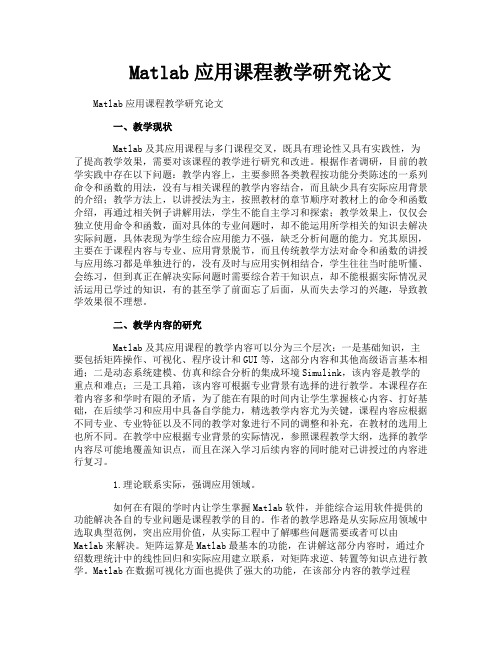
Matlab应用课程教学研究论文Matlab应用课程教学研究论文一、教学现状Matlab及其应用课程与多门课程交叉,既具有理论性又具有实践性,为了提高教学效果,需要对该课程的教学进行研究和改进。
根据作者调研,目前的教学实践中存在以下问题:教学内容上,主要参照各类教程按功能分类陈述的一系列命令和函数的用法,没有与相关课程的教学内容结合,而且缺少具有实际应用背景的介绍;教学方法上,以讲授法为主,按照教材的章节顺序对教材上的命令和函数介绍,再通过相关例子讲解用法,学生不能自主学习和探索;教学效果上,仅仅会独立使用命令和函数,面对具体的专业问题时,却不能运用所学相关的知识去解决实际问题,具体表现为学生综合应用能力不强,缺乏分析问题的能力。
究其原因,主要在于课程内容与专业、应用背景脱节,而且传统教学方法对命令和函数的讲授与应用练习都是单独进行的,没有及时与应用实例相结合,学生往往当时能听懂、会练习,但到真正在解决实际问题时需要综合若干知识点,却不能根据实际情况灵活运用已学过的知识,有的甚至学了前面忘了后面,从而失去学习的兴趣,导致教学效果很不理想。
二、教学内容的研究Matlab及其应用课程的教学内容可以分为三个层次:一是基础知识,主要包括矩阵操作、可视化、程序设计和GUI等,这部分内容和其他高级语言基本相通;二是动态系统建模、仿真和综合分析的集成环境Simulink,该内容是教学的重点和难点;三是工具箱,该内容可根据专业背景有选择的进行教学。
本课程存在着内容多和学时有限的矛盾,为了能在有限的时间内让学生掌握核心内容、打好基础,在后续学习和应用中具备自学能力,精选教学内容尤为关键,课程内容应根据不同专业、专业特征以及不同的教学对象进行不同的调整和补充,在教材的选用上也所不同。
在教学中应根据专业背景的实际情况,参照课程教学大纲,选择的教学内容尽可能地覆盖知识点,而且在深入学习后续内容的同时能对已讲授过的内容进行复习。
MATLAB结课论文设计
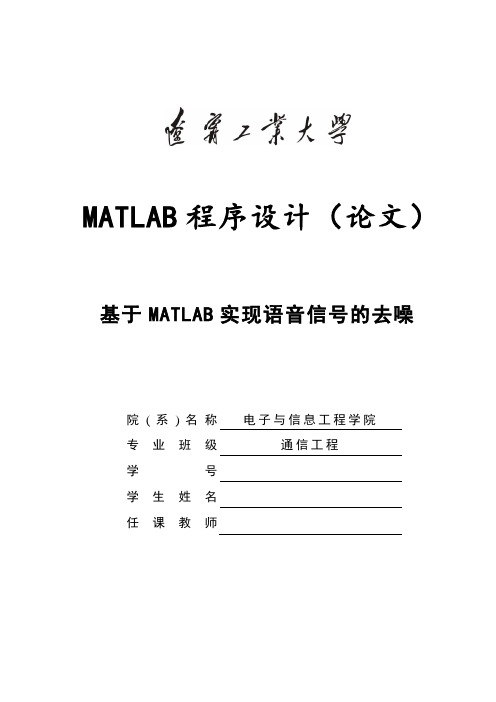
MATLAB程序设计(论文)基于MATLAB实现语音信号的去噪院(系)名称电子与信息工程学院专业班级通信工程学号学生姓名任课教师论文任务给定一段带噪语音(mp3文件格式)1.将带噪语音abc。
mp3读入MATLAB内存2.画出时域波形图,3.画出频谱图4. 分析该段语音文件的频谱图5. 设计语音信号去噪方案6.编写代码实现语音信号去噪7。
将纯净语音重新合成mp3文件7。
总结设计方案,分析实验效果,撰写论文摘要滤波器设计在数字信号处理中占有极其重要的地位,FIR数字滤波器和IIR 滤波器是滤波器设计的重要组成部分。
利用MATLAB信号处理工具箱可以快速有效地设计各种数字滤波器。
课题基于MATLAB有噪音语音信号处理的设计与实现,综合运用数字信号处理的理论知识对加噪声语音信号进行时域、频域分析和滤波.通过理论推导得出相应结论,再利用MATLAB 作为编程工具进行计算机实现。
在设计实现的过程中,使用窗函数法来设计FIR数字滤波器,用巴特沃斯、切比雪夫和双线性变法设计IIR数字滤波器,并利用MATLAB 作为辅助工具完成设计中的计算与图形的绘制。
通过对对所设计滤波器的仿真和频率特性分析,可知利用MATLAB信号处理工具箱可以有效快捷地设计FIR和IIR数字滤波器,过程简单方便,结果的各项性能指标均达到指定要求.关键词数字滤波器 MATLAB 窗函数法巴特沃斯切比雪夫双线性变换目录第1章绪论 01。
1数字信号处理的意义 01。
2语音去噪设计要求 (1)第2章语音去噪方案设计 (2)2.1语音去噪的应用意义 (2)2.2 语音去噪设计框图 (2)2.3设计原理 (3)第3章程序分析 (4)3。
1 语音去噪采样过程 (4)3。
2 语音去噪方案 (5)第 4 章总结 (7)参考文献 (8)附录 (9)第1章绪论1.1数字信号处理的意义数字信号处理是利用计算机或专用处理设备,以数值计算的方法对信号进行采集、抽样、变换、综合、估值与识别等加工处理,借以达到提取信息和便于应用的目的.它在语音、雷达、图像、系统控制、通信、航空航天、生物医学等众多领域都获得了极其广泛的应用。
matlab选修课结课论文
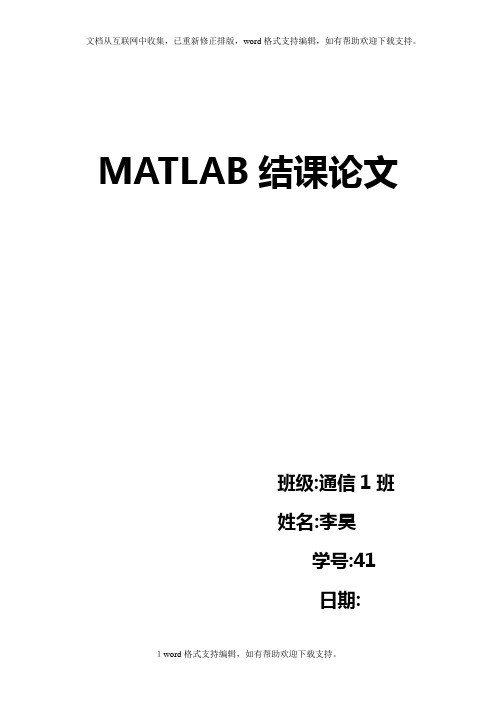
MATLAB结课论文班级:通信1班姓名:李昊学号:41日期:信号时域变换与频谱分析摘要:本论文详细介绍了基于MATLAB实现的离散序列时域变换与运算演示程序的设计与实现过程,还介绍了利用Matlab软件设计实现信号频谱的基本分析原理及功能,该程序用直观、形象的二维曲线,展示了离散序列时域运算与变换的实现过程和规律,使学习人员直观、感性地了解和掌握信号与系统的基本知识。
关键词:MATLAB、时域变换、频谱分析MATLAB的主要特点有以下几点:●高效的数值计算和符号计算功能,能使用户从繁琐的数学运算分析中解脱出来。
●完备的图形处理功能,实现计算结果和编程的可视化。
●友好的用户界面及接近数学表达式的自然语言,使学习者易于学习与掌握。
●功能丰富的应用工具箱,为用户提供了大量方便实用的处理工具。
MATLAB产品组被广泛地应用于包括信号与图象处理、控制系统设计、通信、系统仿真等诸多领域。
开放式的结构使MATLAB产品组很容易针对特定的需求进行扩充,从而在不断深化对问题的认识的同时,提高自身竞争力。
信号的时域运算与变换信号的概念与系统的概念是紧密相连的。
信号在系统中按照一定规律运动、变化;系统对输入信号进行“加工”和“处理”而得到输出信号。
通常输入信号称为激励,输出信号称为响应。
基本概念信号常可表示为时间函数(或序列),该函数的图像称为信号的波形。
根据信号定义域的特点可分为连续时间信号和离散时间信号。
1 连续时间信号在连续时间范围内 (-∞<t <∞) 有定义的信号称为连续时间信号,简称连续信号。
这里“连续”是指函数的定义域——时间(或其它量)是连续的,至于信号的值域可以是连续的,也可以不是。
连续时间信号示例:)t sin(10)(1π=t f ,-∞<t<∞;⎪⎪⎩⎪⎪⎨⎧><<-<<--<=3, 031 , 111 , 11 , 0)(2t t t t t f ; ⎪⎪⎩⎪⎪⎨⎧>=<=0 t, 10 t , 210 , 0)(t t ε;图1 连续时间信号2 离散时间信号只有在一些离散的瞬间才有定义的信号称为离散时间信号。
MATLAB课程设计论文.doc
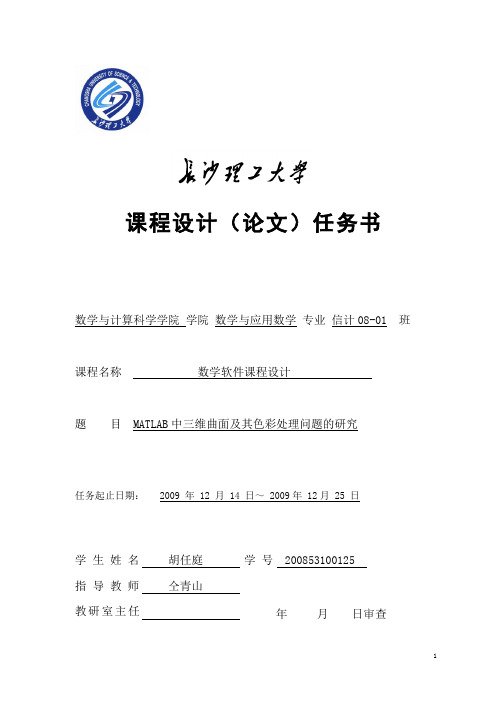
课程设计(论文)任务书数学与计算科学学院学院数学与应用数学专业信计08-01 班课程名称数学软件课程设计题目 MATLAB中三维曲面及其色彩处理问题的研究任务起止日期: 2009 年 12 月 14 日~ 2009年 12月 25 日学生姓名胡任庭学号 200853100125指导教师仝青山教研室主任年月日审查课程设计(论文)任务注:1. 此任务书由指导教师填写。
如不够填写,可另加页。
2. 此任务书最迟必须在课程设计(论文)开始前下达给学生。
学生送交全部材料日期学生(签名)指导教师验收(签名)第1章构建三维MATLAB图形1.1 构建三维曲面的基本步骤………………………………………………………1.2 曲面矩阵的描述…………………………………………………………………1.2.1 网格和曲面图形的绘制…………………………………………………1.2.2 随机采样曲面图形数据…………………………………………………1.2.3 参数化曲面图形…………………………………………………………1.2.4 曲面图形透明处理………………………………………………………第2章三维MATLAB曲面色彩处理2.1 网格和曲面图形的着色………………………………………………………2.1.1 颜色映射表………………………………………………………………向量与色图矩阵2.1.2曲面曲率的颜色映射……………………………………………………2.2 曲面的光照处理…………………………………………………………………MATLAB中,三维图形的创建一般按照下面的步骤进行:(1)数据准备典型代码为:Z=peaks(20);(2)选定创建三维图形的窗口,并在窗口中确定图形绘制的区域典型代码为:figure(1)subplot(2,1,2)(3)调用三维图形函数典型代码为:h=surf(Z)(4)确定颜色映射方案和三维阴影算法典型代码为:colormap hotshading imterpset(h,’EdgeColor’,’k’)或添加灯光效果。
- 1、下载文档前请自行甄别文档内容的完整性,平台不提供额外的编辑、内容补充、找答案等附加服务。
- 2、"仅部分预览"的文档,不可在线预览部分如存在完整性等问题,可反馈申请退款(可完整预览的文档不适用该条件!)。
- 3、如文档侵犯您的权益,请联系客服反馈,我们会尽快为您处理(人工客服工作时间:9:00-18:30)。
2019年秋学期《matlab 》课程论文写作要求:
(作为期末考查方式占课程分数20%)
论文主题:自选跟matlab 相关的主题。
也可参考以下列表领域选择其中某一主题:
1.利用matlab 进行选择结构程序设计
2.利用matlab 进行循环结构程序设计
3..matlab 的高层绘图操作
4.利用matlab 进行GUI 设计
5. matlab 符号计算基础与符号微积分
6.matlab 与方程符号求解
7.利用simulink 进行系统仿真
8.利用matlab 进行电路分析
9.利用matlab 进行信号处理
10.利用matlab 进行图像处理
11.其他与本课程相关即可。
论文要求:
1.字数不得低于2000 字,但不得超过5000 字。
2.必须要附有论文里实例源文件。
(M 文件、MDL 文件或fig 文件)
3.格式要求按杂志期刊论文投稿格式要求来撰写(参考文后附录)。
4.论文正文中必须包含图、表格。
特此通告:
课程论文若有以下情况之一,无论平时成绩如何,整个课程作不及格处理。
1.雷同论文。
如有同学论文雷同,全部作为不及格处理。
2.完全拷贝网上论文或教材章节的论文。
3.没有上交源文件。
4.没有上交课程论文。
论文上交:
上交清单:
(1)word 版论文
(2)源文件(M文件、MDL文件或fig文件)
(3)论文打印版本(请学习委员收集齐后给我上交)
XXXX(中文标题:二号黑体,居中)
作者(作者名:四号仿宋体,居中)
摘要:(五号黑体,缩进两格)xxxxx(摘要内容:五号楷体)
关键词:(五号黑体,缩进两格)词1,词2,词3(五号宋体)
0 引言(四号宋体,顶格)
xxxxxxxxxxxxxxxxxxxxxxxxxxxxxxxxxxxxxxxxxxxxxxxxxxxxxxxxxxxxxxxxxxxxxxxxxxxx xxxxxxxxxx......(正文:五号宋体,每段首行缩进两格)
1 XXXXX(四号宋体,顶格)
xxxxxxxxxxxxxxxxxxxxxxxxxxxxxxxxxxxxxxxxxxxxxxxxxxxxxxxxxxxxxxxxxxxxxxxxxxxxx xxxxxxxxxxxx......(正文:五号宋体,每段首行缩进两格)
1.1 XXXX(五号黑体,顶格)
1.1.1 xxxx(五号楷体,顶格)
xxxxxxxxxxxxxxxxxxxxxxxxxxxxxxxxxxxxxxxxxxxxxxxxxxxxxxxxxxxxxxxxxxxxxxxxxxxxxx xxxxxxxxxxxxx.........(正文:五号宋体,每段首行缩进两格)
图
图1 XXX(图名:小五号宋体,居中列于图下)
1.1.2 xxxx(五号楷体,顶格)
xxxxxxxxxxxxxxxxxxxxxxxxxxxxxxxxxxxxxxxxxxxxxxxxxxxxxxxxxxxxxxxxxxxxxxxxxxxxxx xxxxxxxxxxxxx.........(正文:五号宋体,每段首行缩进两格)
表1 XXXX (表题:小五号黑体,居中排于表格上方)
参考文献:(五号黑体,顶格)
[1] xx (英文摘要:六号Times New Roman,缩进两格)
[2] xxx (中文摘要:六号宋体,缩进两格)
xxx(对照英文格式:六号Times New Roman,缩进两格)
[3] xxx (中文摘要:六号宋体,缩进两格)
xxx(对照英文格式:六号Times New Roman,缩进两格)
[4] xxx。
